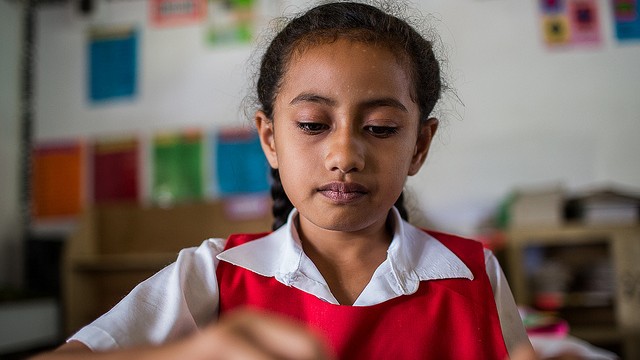“Those kids are often really talented in the real world,” said Ron Berger, chief academic officer for Expeditionary Learning, a network of schools that has pioneered the deeper learning movement. “In real life they thrive in many ways, so the more ways that we can make academic work connect to the real world, we let those kids thrive.”
To that end, educators have to move past the idea that learning is a linear process. “It’s crazy to separate basic skills from engaging complex work,” Berger said. Instead, the basic skills should be in service of something exciting to students because few students show their capacity through textbook work.
An example of a project that meets every learner at their skill level was done in a fourth grade Spanish class in which there were students who had never studied Spanish before alongside native speakers. The teacher partnered with a school in Guatemala online that also had Spanish language learners because its students mostly spoke indigenous languages like Mayan. The two classrooms wrote books for one another. Some books had complicated story lines and others were simpler, but the project gave each student the chance to contribute something meaningful. “They all created something beautiful and of quality,” Berger said.
CREATING STRUCTURES FOR SUCCESS
Reaching all learners successfully is a tough job and requires carefully thought-out structures. “There's a misperception that deeper learning is unstructured,” Berger said. “It’s really just a question about what you’re going to be tight and loose about. In traditional classrooms they are tight about pacing and about kids being quiet. I’d rather be tight about kids being focused and courteous.” Changing the focus might make for a more chaotic classroom, but meaningful learning is often happening between students in that environment. “It’s an active peer-driven sense of working towards quality,” Berger said. “It’s not just sitting passively and letting someone tell you what to think.”
Careful grouping is important to give all learners the best chance at success. “The key thing about deeper learning for the kids we work with is not whether they can do it, but how can we structure classrooms so they can be successful,” said Joe Luft, senior director of programs for the Internationals Network and a former teacher and principal at one of their schools.
“You want to be able to support students academically and in terms of literacy,” said Rosemary Milczewski, a math teacher at Flushing International High School. “They are arguing; they are talking to each other; and I’m walking around as a facilitator.” A common way to teach students for whom English isn’t their first language is to group them by proficiency. But Sylvan says that rarely works. Grouping is a delicate balance of English language ability, native language ability, and familiarity with the academic content. “The grouping would differ based on the task you are asking students to do,” Sylvan said.
TEACHER GROUPING
In addition to carefully grouping students for project work, it can be very helpful to group teaching staff to best serve the needs of students. At Internationals High Schools, five teachers all work with the same group of students. They coordinate closely on the literacy goals that cross all classes in addition to developing interesting projects together. For example, all teachers may be working on helping students use language to compare and contrast or to use cause and effect language, no matter what subject they teach.
Creating class structures that support student-self esteem and promote an open culture also help reluctant or traditionally hard-to-reach students. “The first thing that comes to mind for me is changing students' perceptions of themselves so they don’t see themselves as unable to learn,” said Thabiti Brown, principal of Codman Academy, a Boston charter school in the process of growing to be a K-12 school. “If they are thinking about themselves as students who are exercising that muscle, the brain, then it changes their perception of themselves.” Students also need to feel permission to express themselves and to know that their input is valued.
Milczewski immigrated to the U.S. when she was a teenager and attended an Internationals School. She uses her story to motivate her students and create a community of learners. “Telling them my story, I feel like it gives them some hope,” she said. “They realize they can graduate from high school, go to college and all they’ve got to do is work hard.”
SCHOOL STRUCTURES TO PROMOTE SUCCESS
Teachers working with challenged students need extra time to plan, tutor, and work together. We need a lot of different time to meet in lots of different configurations around a lot of different issues,” said Ben Daley, chief academic officer at High Tech High. At Flushing Internationals School teachers meet for two hours each week to discuss instructional work and ways to support specific students. They plan the language function and outcomes they’ll be working on and talk logistics.
Additionally, each week they meet to talk about social and emotional needs of students, and there’s always a morning meeting for team leaders to report back on the school-wide administrative issues. In addition to all of that, teachers are on committees to help make decisions about the schools. These school-wide structures help teachers feel supported and connected in their difficult work and keep the staff on the same page about learning goals, but they are often built into the school day, not an addition.


